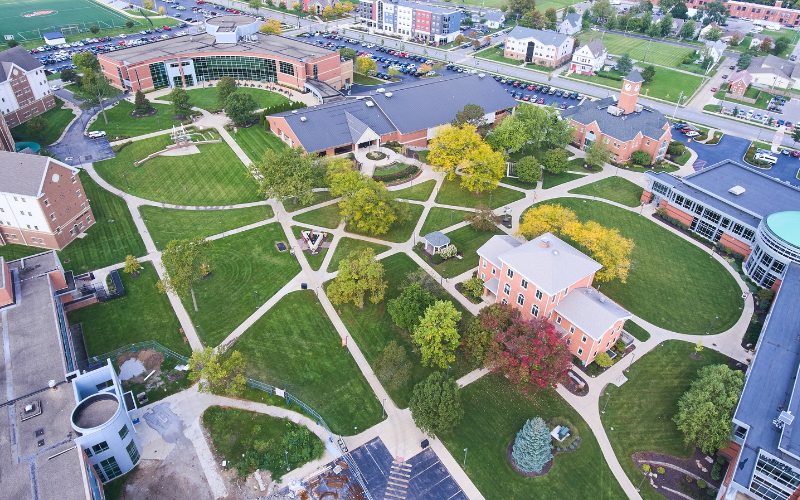Financial pressures are causing several states to consider consolidating public universities. These institutions face declining enrollments and college operating costs increasing at rates higher than consumer inflation. Meanwhile, state budgets are not recovering from COVID-19 especially after federal pandemic subsidies expire. Higher education’s status as a non-mandated state benefit has led many legislators to closely examine the operating costs of each of its colleges and universities.
Last month, I wrote about a university president’s proposals to reduce a forecasted $100 million operating loss at Penn State University. In that same article, I wrote about Pennsylvania’s governor’s proposed blueprint for higher education. After Pennsylvania’s announcements made the national news, I nearly missed reading about a proposed bill that may cause Mississippi to close public universities.
Mississippi State Senator Proposes Bill 2726
Inside Higher Ed’s Josh Moody wrote about Mississippi Senate Bill 2726 on February 28. The proposed bill orders the Board of Trustees of State Institutions of Higher Learning (IHL) to choose three of the state’s public universities to close by June 30, 2028.
By June 30, 2025, the Board is required to announce which institutions are to be closed.
The proposed Bill specifies factors that the Board should consider, including:
- Enrollment data and degree attainment percentage
- Federal aid, including grants provided for scholarship and research;
- Tuition rates and scholarship endowments;
- Degrees offered, including graduate degrees and doctorate degrees or other professional degrees;
- An institution’s economic impact on the local community, region, and state;
- Any additional purposes that the institution currently serves to the state and its citizens, including medical services, agriculture research, engineering research or services; and
- Any other special factors that the Board believes the institution offers that cannot be easily replaced or replicated.
Mr. Moody wrote that three historically black universities—Alcorn State, Jackson State, and Mississippi Valley State—are among the institutions that would be considered for closure. The Bill was being considered by the Senate’s Universities and Colleges Committee. If it advances from that Committee, it would be considered by the Senate for passage.
After reading Mr. Moody’s short article, I searched for other articles about the Bill. Grant McLaughlin of the Mississippi Clarion Ledger reported that a Mississippi senator wants to close 3 state universities by 2028 – see why. McLaughlin wrote that the lowest enrollments in the fall of 2023 were at Delta State University, Mississippi University for Women, and Mississippi Valley State University.
McLaughlin reported that the Bill proposes to sell the land and buildings from the closed institutions to local non-profits or gift them to other state agencies. Any research laboratories could be gifted by the IHL to other universities.
The final paragraph of McLaughlin’s article reports the Fall 2023 enrollments for each of the state’s eight public institutions (UMMC is the medical college of the University of Mississippi and does not directly admit undergraduates). I listed his enrollment numbers in Table 1 below.
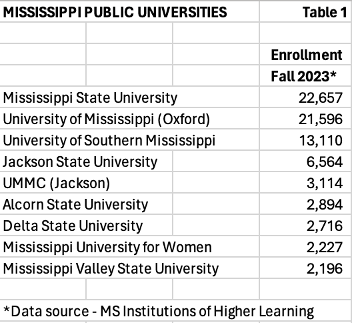
After the publication of Inside Higher Ed’s article, The Chronicle of Higher Education’s Alecia Taylor reported that the proposed “Bill Touched a Nerve.” More specifically, she wrote that it prompted speculation that HBCUs were the target.
Ms. Taylor wrote that in 2009, Mississippi’s then-governor, Haley Barbour, tried to merge Alcorn State University, Jackson State University, and Mississippi Valley State University, three HBCUs. The proposal failed.
Mississippi State Senator Committee Chair Proposes Bill 2725
More recently, Mississippi Today’s Molly Minta reported on March 5 that Senate Bill 2726 was going to die in the Universities and Colleges Committee. The Committee’s chair, Nicole Boyd, advanced Senate Bill 2725 that will create a “Mississippi University System Efficiency Task Force” to examine the efficiency and effectiveness of the public university system.
The preamble of Bill 2725 incorporates some of the concepts like declining enrollment and increasing college graduation rates that were included in Bill 2726. Bill 2725 specifies that the majority of the Task Force will be Senate and House-elected politicians. The task force will meet in 45 days and will:
- Evaluate the current funding formula and appropriations process for the Mississippi public university system, particularly as it relates to enrollment and graduation rates;
- Evaluate the process of developing physical plant plans for Mississippi’s public universities, including the use of enrollment data and projections in such plans and the Mississippi Institution of Higher Learning’s role in determining collective system needs requiring additional state resources;
- Collect and analyze publicly available data and statistics related to enrollment and graduation rates and projections, with a particular focus on the enrollment and graduation rates of Mississippi residents, as well as other data related to shifting demographics, at all Mississippi public universities;
- Examine any existing or developing plans, both on an individual public university and system basis, to address projected demographic shifts and enrollment declines;
- Evaluate successful strategies for addressing challenges in efficiency and enrollment in the Mississippi university system and across the nation, including current partnerships across the system;
- Review any other matters related to the above issues or the efficiency and effectiveness of the public university system in Mississippi.
Bill 2725 requires the Committee to report its results to the Legislature by October 1, 2024.
Senator Boyd told Mississippi Today that closing universities is not off the table but that her goal is to ensure that tax dollars are meeting the universities’ needs. She also responded to inquiries that Bill 2726 was intended to close three HBCUs by stating “what [it’s] legislation said and what it was purported to say were entirely two different things.”
Will Mississippi Close Any State Universities?
It’s my belief that the handwriting is on the wall that Mississippi will consider closing low-enrollment and/or low performing state universities. I decided to examine some of the data available for these institutions through College Navigator. I looked for any obvious institutions with the potential of being closed or consolidated.
In Table 2 below, I aggregated the data specified in Bill 2725 related to enrollment and graduation rates. The data is sourced from College Navigator. I have no access to projections for any of the universities listed.
The institutions are listed in order of enrollment, from highest to lowest. As might be expected, the flagship (University of Mississippi – Oxford) and land grant (Mississippi State University) have the largest enrollments. I also included the percentages of Black and White students since some had speculated that Bill 2726 (now dead) called for HBCU closures.
The table illustrates that not only do the flagship university (UMiss) and land grant university (Mississippi State) have the largest total enrollments, they also have the highest percentages of white students and the lowest percentages of Black students. Will they admit any student from a university that may be closed as a result of this analysis?
Based on enrollment data alone, I would question the operational efficiency of the four lowest enrollment institutions. Two of those four are HBCUs. Sadly, those four also have the lowest graduation rates. Unfortunately, none of Mississippi’s public universities disclosed their transfer rates, which could explain a portion of the lower graduation rates.
Only the two largest and arguably most prestigious state universities have six-year graduation rates that approximate or exceed the national average of 65%. There are two institutions (Jackson State and Mississippi University for Women) with six-year graduation rates below 40% and one (Mississippi Valley State) with a six-year graduation rate below 30%.
There are many reasons why students drop out of college, and it is usually not related to the quality of the college. One of the top explanations relates to finances. As I’ll show later, the sources of funding, as compared to the costs of attendance, are not generous, particularly for those students with limited financial means.
I hope that the politicians comprising much of the Committee analyze the state’s financial aid funding model, particularly for its poorest families. The public deserves a partial explanation for why graduation rates may be lower at certain institutions.
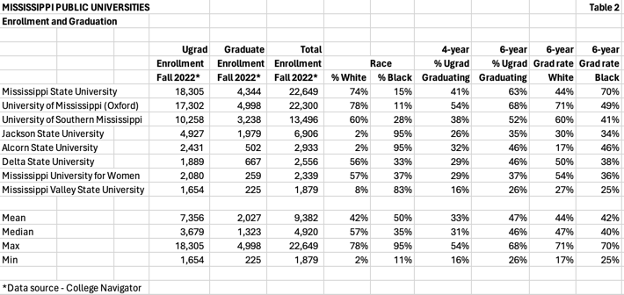
Much of the other data to be used by the Committee created under Bill 2725 is not publicly available. Therefore, I opted to use more College Navigator data to evaluate some of the enrollment and graduation findings.
In Table 3 below, I have listed enrollments for each institution as well as the percentages of in-state and out-of-state students. Three of the four institutions with the highest enrollments (including Jackson State, an HBCU) have an out-of-state student percentage equal to or greater than 40%. Bill 2725 specified outcomes for state residents.
Interestingly, the state flagship University of Mississippi has the second-highest percentage of out-of-state students (63%). Referring to Table 2, you can see that it also has the highest percentage of white students (78%).
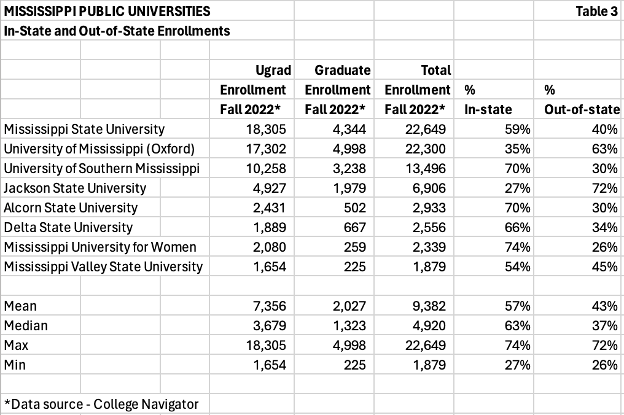
There’s a common explanation for high percentages of out-of-state students attending public universities. The spread between the in-state tuition and the out-of-state tuition subsidizes some of the universities’ costs. In Table 4 below, I have listed the detailed components of the cost of attendance for each of the eight universities.
The spread between in-state and out-of-state tuition is greatest at Mississippi State ($16,765) and the University of Mississippi ($17,568). Their cost of attendance for out-of-state students approximates $46,000. Incidentally, that spread in tuition costs is lower than the average for public universities ($22,500) outlined in Table 1 in my August article. The Mississippi average out-of-state cost of attendance is approximately $7,000 per year less as well.
The four lowest enrollment institutions do not differentiate between in-state and out-of-state tuition even though they depend on those students for overall enrollment totals, as illustrated in Table 3 above.
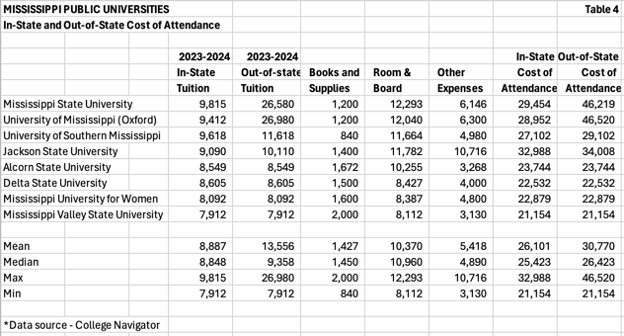
Use of federal grants and other funding was mentioned as an important factor to consider in Bill 2726. Without plowing through other data sources, I opted not to search for research grants. I opted to review the components of financial aid funding.
In Table 5 below, you can see that all but one ( U Miss) of the eight universities award financial aid to more than 95% of their students. In fact, the median percentage is 98%. The percentage of students receiving Pell Grants ranges from a high of 79% at Alcorn State to a low of 19% at the University of Mississippi (Oxford).
I usually don’t see many colleges and universities detailing other federal grants. I assume these may be limited to federal student grants due to COVID-19. These grants vary from a high of 92% at Mississippi University for Women to a low of 13% at the University of Southern Mississippi. The median percentage is 36%.
Approximately 30% of the university’s students receive state and local grants. These range from a high of 41% at the University of Southern Mississippi to a low of 9% at Jackson State University.
The mean (67%) and median (72%) are close to the percentage of students receiving institutional grants. These range from a high of 93% at Mississippi State to a low of 20% at Jackson State.
The percentage of students utilizing federal loans usually varies based on how many full-pay students attend a university as well as the size of the university endowment. Bill 2726 requested a look at endowment balances. The mean percentage of students borrowing federal loans is 57%. The percentages range from a high of 84% at Jackson State to a low of 34% at the University of Mississippi (Oxford).
Other loans average four percent of all students and range from a high of eight percent at the University of Mississippi to a low of 0% at Alcorn State and Delta State.
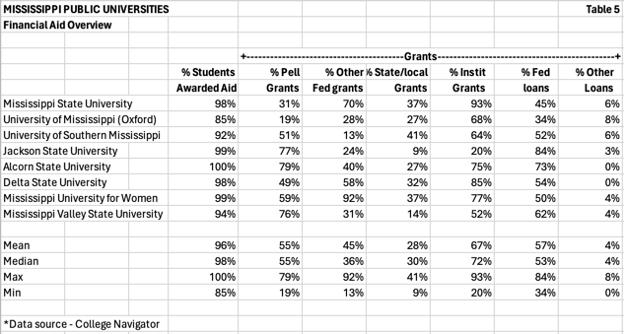
Reviewing the percentage of students receiving multiple components of financial aid is illuminating, but it’s more revealing when you review the average award (shown in dollars). Table 6 below compares the in-state and out-of-state costs of attendance with the average values of grants and loans received.
One question I would ask if I were on the Committee for Bill 2725 would be who receives the institutional grants, in-state or out-of-state students? Notably, the three universities with the highest percentage of out-of-state students also issue the highest dollar average institutional grants. All three are over $10,000, while the median for the group is $5,638.
Interestingly, Pell Grants (average $5,688) approximate Federal loans (average $5,797). Those two components would barely cover half of the lowest in-state COA at Mississippi Valley State and approximately one-third of the highest in-state COA at Jackson State. Clearly, legislators should evaluate the adequacy of their funding.
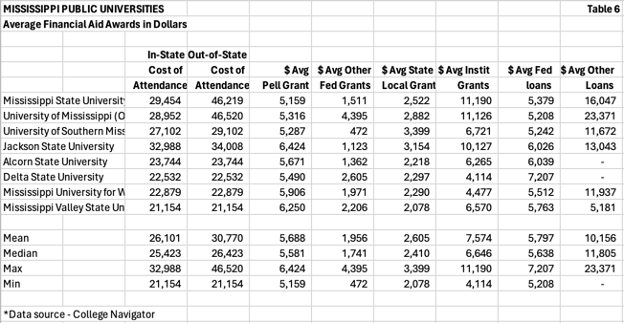
If you care about your state’s poorest residents, you should examine the breakout of net price by income quintile as reported by College Navigator. As you may recall, College Navigator reports net price as the In-State COA minus all grants. In Table 7 below, I have provided the net price for each of the universities in each of the five quintiles.
Mirroring my previous comment that the average Pell Grant and Federal loan do not cover the cost of attendance, you can see this more directly with the average net price as well as the average net price based on family income. Overall, the average net price ranges from a high of $15,364 at Mississippi State to a low of $11,598 at Mississippi Valley State.
Theoretically, universities should provide higher grants to poorer students. If the institution doesn’t have a generous endowment or a high percentage of full-pay families, it relies on Pell Grants as its primary source of grants. There are only two universities with net prices less than $10,000 for the lowest income quintile. These are Mississippi Valley State ($9,724) and the University of Mississippi ($8,933).
Kudos to Mississippi Valley State for utilizing its financial aid packaging to award the most grant money to its poorest students. It has a much lower overall enrollment, lower out-of-state enrollment, lower percentage of full-pay families, and likely a lower endowment than the University of Mississippi.
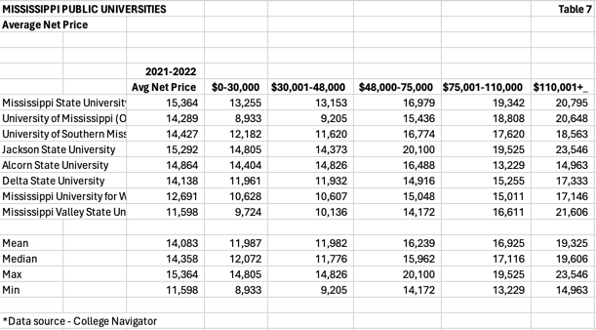
Final Thoughts
Mississippi is one of America’s poorest states. In fact, it has the lowest median household income in the U.S. at $44,966. That means that more than half of its families would fall into the two lowest quintiles in the net pricing table in Table 7.
I know of no one who would argue that everyone, regardless of income, should have the opportunity to attend college. At the same time, states depend on income taxes to fund their state colleges and universities. Bill 2725 has not yet moved through the Senate Committee.
If Mississippi is concerned about adequate funding for its colleges and universities, it should include all its colleges and universities in its review. There are 15 community colleges in Mississippi.
With online courses and programs gaining in popularity across the country, maybe a geographical consolidation of several locations with an expansion of online courses and programs could provide valuable funding to offset the limited aid to the state’s poorest families.
Despite its location in the growing Southeastern U.S., Mississippi’s population growth is flat to slightly declining. Providing a more affordable state college system for its residents could be a way to take advantage of its location, attract more businesses, and increase its population of higher-than-average wage earners.
I predict that Senate Bill 2725 will pass. After all, the Chairman of the Universities and Colleges Committee sponsored it. I hope they consider modifying the bill to include all institutions, not just the eight universities. I also hope that the Committee members take the time to deeply analyze the factors for college dropouts and lower graduation rates and conclude that greater financial aid support is needed.
The Bill must clear the committee and pass the Senate. Assuming that it does, it will be interesting to read the Committee’s analysis and recommendations in the fall.
